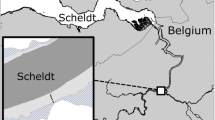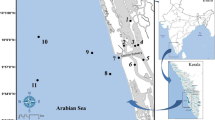Abstract
The vertical distribution of infauna was quantified in eight strata from 0–35 cm in sand and mud sediments of a lower mesohaline subestuary of Chesapeake Bay. Large numbers of small polychaetes, amphipods, and clams occurred in the upper 5 cm of both sediment types, whereas large clams (Macoma balthica in mud andMya arenaria in sand) extended down to 30 cm and comprised most of the biomass in their respective sediment types. There was extensive overlap of the species inhabiting both sediment types. Vertical stratification within and among species apparently reflected constraints on burrowing depth related to body size rather than resource partitioning among competitors. The maximal sediment penetration of 35 cm, which was exhibited byHeteromastus filiformis, was considerably less than the maximal penetration for deep burrowing species in some marine infaunal communities. Several species which burrowed deeper than 5 cm exhibited significant temporal shifts in their vertical distribution.
Similar content being viewed by others
Literature Cited
Blundon, J. A., andV. S. Kennedy. 1982. Refuges for infaunal bivalves from blue crab,Callinectes sapidus Rathbun, predation in Chesapeake Bay.J. Exp. Mar. Biol. Ecol. 65:67–81.
Brenchley, G. A. 1979. On the regulation of marine infaunal assemblages at the morphological level: A study of the interactions between sediment stabilizers, destabilizers, and their sedimentary environment. Ph.D. Dissertation, The Johns Hopkins University, 248 p. Baltimore.
Cory, R. L., and P. V. Dresler. 1981. Diel oxygen variations in the Rhode River estuary, Maryland, 1970–1978. U.S. Geological Survey, Water Resources Investigations 81-10, 14 p. Reston.
Dauer, D. M., C. A. Maybury, andR. M. Ewing. 1981. Feeding behavior and general ecology of several spionid polychaetes from the Chesapeake Bay.J. Exp. Mar. Biol. Ecol. 54:21–38.
Diaz, R. J. 1980. Ecology of tidal freshwater and estuarine Tubificidae (Oligochaeta). p. 319–330.In R. O. Brinkhurst and D. G. Cook (eds.), Aquatic Oligochaeta Biology. Plenum Press, New York.
Eauchald, K., andP. A. Jumars. 1979. The diet of worms: A study of polychaete feeding guilds.Oceanog. Mar. Biol. Ann. Rev. 17:193–284.
Hines, A. H., andT. R. Loughlin. 1980. Observations of sea otters digging for clams at Monterey Harbor, California.Fish. Bull. 78:159–163.
Holland, A. F., N. K. Mountford, M. H. Hiegel, K. R. Kaumeyer, andJ. A. Mihursky. 1980. Influence of predation on infaunal abundance in upper Chesapeake Bay, U.S.A.Mar. Biol. 57:221–235.
Johnson, R. G. 1967. The vertical distribution of the infauna of a sand flat.Ecology 48:571–578.
Levinton, J. S. 1977. Ecology of shallow water deposit-feeding communities Quisset Harbor, Massachusetts, p. 191–227.In B. C. Coull (ed.), Ecology of Marine Benthos, Vol. 6. Belle W. Baruch Library in Marine Science, Univ. South Carolina Press, Columia.
Loi, T-N., andB. J. Wilson. 1979. Macroinfaunal structure and effects of thermal discharges in a mesohaline habitat of Chesapeake Bay, near a nuclear power plant.Mar. Biol. 55:3–16.
Mare, M. F. 1942. A study of a marine benthic community with special reference to the micro-organisms.J. Mar. Biol. Assoc. U.K. 25:517–554.
Mountford, N. K., A. F. Holland, andJ. A. Mihursky. 1977. Identification and description of macrobenthic communities in the Calvert Cliffs region of the Chesapeake Bay.Chesapeake Sci. 18: 360–369.
Myers, A. C. 1977. Sediment processing in a marine subtidal sandy bottom community: I. Physical aspects.J. Mar. Res. 35:609–647.
Officer, C. B., R. B. Biggs, J. L. Taft, L. E. Cronin, M. A. Tyler, andW. R. Boynton. 1984. Chesapeake Bay anoxia: Origin, development, and significance.Science 223:22–27.
Peterson, C. H. 1977. Competitive organization of the soft-bottom macrobenthic communities of southern California lagoons.Mar. Biol. 43:343–359.
Peterson, C. H., andS. V. Andre. 1980. An experimental analysis of interspectific competition among marine filter feeders in a soft-sediment environment.Ecology 61:129–139.
Reading, C. F., andS. McGrorty. 1978. Seasonal variations in the burying depth ofMacoma balthica (L.) and its accessibility to wading birds.Estuarine Coastal Mar. Sci. 6:135–144.
Reinharz, E., and A. O’Connell, 1981. Animal-sediment relationships of the upper and central Chesapeake Bay. Final Report, United States Environmental Protection Agency Grant No. R80594. Washington.
Rhoads, D. C. 1974. Organism-sediment relations on the muddy sea floor.Oceanog. Mar. Biol. Ann. Rev. 12:263–300.
Vassallo, M. T. 1971. The ecology ofMacoma inconspicua (Broderip & Sowerby, 1819) in central San Francisco Bay. Part II. Stratification of theMacoma community within the substrate.Veliger 13:279–284.
Virnstein, R. W. 1979. Predation on estuarine infauna: Response patterns of component species.Estuaries 2:69–86.
Whitlatch, R. B. 1980. Patterns of resource utilization and coexistence in marine intertidal depositfeeding communities.J. Mar. Res. 38:743–765.
Author information
Authors and Affiliations
Rights and permissions
About this article
Cite this article
Hines, A.H., Comtois, K.L. Vertical distribution of infauna in sediments of a subestuary of central Chesapeake Bay. Estuaries 8, 296–304 (1985). https://doi.org/10.2307/1351490
Received:
Accepted:
Issue Date:
DOI: https://doi.org/10.2307/1351490




